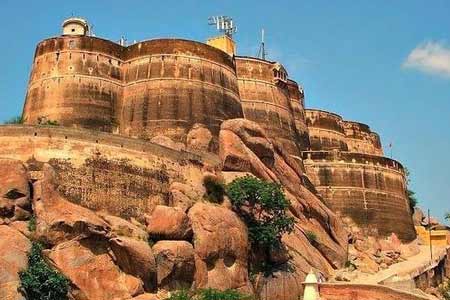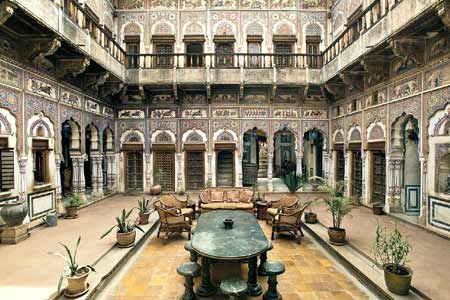
Shekhawati Monuments
The semi desert region of Shekhawati is a colourful fantasy having a fascinating uniquely of its own. The open air art gallery, as it is popularly called is famous for its plethora of painted havelis, all commendable pieces of the rich artistic traditional of this region. 'Shekhawati', meanings the land of Shekhs clan derives its name from Rao Shekha (1433 AD - 1488 AD) a section of the Kachhwaha family of Jaipur. Earlier a part of the former Jaipur state, it now comprises of the districts of Jhunjhunu and Sikar. Initially the region had a blank monochromatic look but with subsequent historical and social development it has blossomed into a colourful profusion of art and life for almost 2 centuries from 1750 AD to 1930 AD
Shekhawati's magnificent havelis or mansions, built by rich merchants of the region, display a unique architectural style that evolved around the courtyards to ensure safety and privacy of the women folk and protection from the heat of the long and harsh summers.
The havelis, painted predominantly in the blue, maroon, yellows, green and indigo have beautiful wall paintings that adorn their walls. The earlier wall paintings (1830 AD -1900 AD) were largely based on the mythological themes, depicting local legends, animals, portraits, hunting and wrestling scenes and a glimpse of everyday life. The turn of the 19th century saw the appearance of new motifs, an outcome of the Raj's influence upon the Indian culture. Now cars, replaced elephants and traditional Indian miniatures mingled with naturalism of western paintings to produce interesting hybrid results. The mythological themes depicting gods, lithographs and photographs, Trains, cars, balloons, telephones gramophones English men in hunting attires and portraits of the haveli owners primly dressed were painted all over the walls-thus making the havelis interesting for both Indian and foreign travellers.
Monuments in Rajasthan
Rajasthan is a popular state worldwide and receives travelers from both international and domestic. Royal land of Rajasthan is famous for its majestic forts, princely palaces, beautiful Havelis with many more attractions which bind visitors to Rajasthan. Explore Rajasthan heritage by its architectural monuments. Some of the most well-known monuments of the state are quiet obviously located in the big cities. However, even the smaller and remote destinations preserve enough of monumental heritage of Rajasthan for tourists. Its world’s famous palaces and Havelis are now converted to top notch hotels. Following are some of the world famous monuments in Rajasthan which attracts travelers in large numbers.
The Pink City of India, Jaipur is the capital city of Rajasthan and have some of the historical forts of Rajasthan. Some major historical places in Jaipur include Amber Fort, Jaigarh Fort, Nahargarh Fort, City Palace, Hawa Mahal or the Palace of Winds, Jal Mahal, Rambagh Palace, etc.
Jodhpur, also known as the Blue City of India, is the second-largest city of Rajasthan. It has Mehrangarh Fort, Umaid Bhawan Palace, Jaswant Thada Memorial, and Balsamand Lake & Palace.
The City of Lakes of Rajasthan is Udaipur is a beautiful city and the land of splendid palaces. Major palaces in this city include Lake Palace, Jagmandir Palace, Fateh Prakash Palace, Shiv Prakash Palace, Monsoon Palace, etc.
There is a massive fort complex called Kumbhalgarh Fort which is located nearby. Junagarh Fort and Lalgarh Palace are also situated in Bikaner which are also very beautiful palaces.
Bharatiya Lok Kala Mandal and Saheliyon-Ki-Bari is also worthy of praise for their beautiful architecture and definitive designs. Laxmi Niwas Palace is also evidence of the beautiful architecture of the Royals.
The Golden City of India, Jaisalmer is a major tourist destination of Rajasthan. It has a Golden Fort which is indeed a beautiful palace in Rajasthan and is the only living forts of India.
More to mention are the Neemrana Fort & Palace, Bharatpur, Lohagarh Fort, Chittorgarh Fort, Kota City Palace, Alwar City Palace, etc are other popular monuments in Rajasthan known for their stunning architectural beauty.
-
Monuments in Jaipur
-
Monuments in Jodhpur
-
Monuments in Udaipur
-
Monuments in Jaisalmer
-
Monuments in Pushkar
-
Monuments in Shekhawati
-
Monuments in Bundi
-
Monuments in Bharatpur
-
Monuments in Ajmer
-
Monuments in Mount Abu
-
Monuments in Alwar
-
Monuments in Bikaner
-
Monuments in Chittorgarh
-
Monuments in Kota
-
Monuments in Mandawa
-
Monuments in Sariska
-
Monuments in Ranakpur
-
Monuments in Khimsar
-
Monuments in Samode
-
Monuments in Ranthambhore
 +91 9549279999
+91 9549279999 











